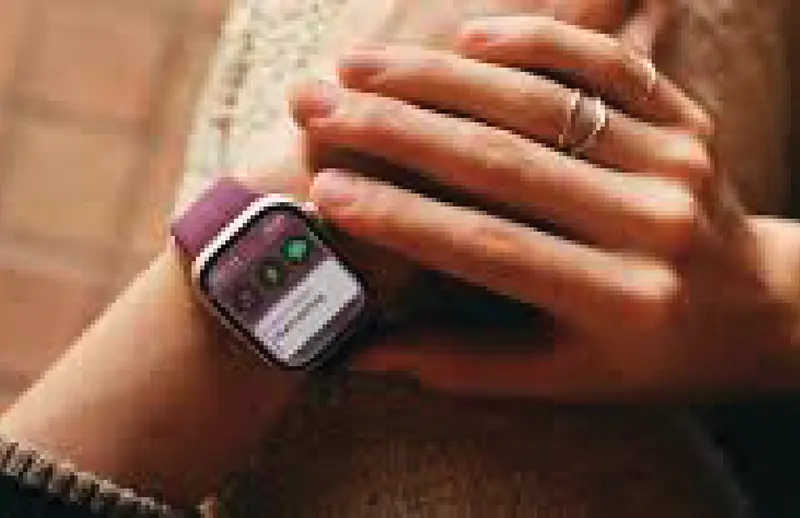NATION — Researchers developed a new way to predict cardiac arrhythmia 30 minutes before it occurs using AI and wearable tech.
About 59 million people worldwide had atrial fibrillation (AFib) in 2019, making it the most common type of cardiac arrhythmia, also known as an irregular heartbeat. While AFib itself is not usually life threatening, it is a serious condition that may increase a person’s risk of mortality from cardiovascular conditions such as stroke, heart attack, and heart failure.
People with AFib may also have a higher chance of developing diseases such as dementia and gastrointestinal and liver diseases.
The earlier a person receives an AFib diagnosis the better their outcomes may be.
To help provide earlier interventions for AFib, scientists from the University of Luxembourg have developed a way to predict cardiac arrhythmia about 30 minutes before it occurs by using artificial intelligence (AI) and electrocardiogram information gathered through wearable devices.
The study was recently published in the journal Patterns.
AI detects early warning sign of AFib
For this study, researchers developed an AI model called WARN (Warning of Atrial fibRillatioN) to help predict AFib.
“WARN consists of a deep learning model that inputs short segments of 30 seconds of heart rate and outputs the probability of an imminent switch to AFib,” Jorge Gonçalves, PhD, professor at the Luxembourg Centre for Systems Biomedicine at the University of Luxembourg and lead author of this study explained to Medical News Today.
“The higher this probability of danger, the higher the chance to transition to AFib. This is repeated every 15 seconds. When this probability crosses a specific threshold, it triggers a warning,” Gonçalves said.
The WARN system was trained and tested on 24-hour recordings of electrocardiogram data gathered through Holter devices worn by 350 people at Tongji Hospital in Wuhan, China.
“AI has shown incredible performance when looking for patterns in large-scale datasets,” Gonçalves said.
“Such patterns are in most instances very difficult to be identified by humans. Hence, we tested the hypothesis on whether there was some ‘hidden’ information in heart rate in the minutes leading to a transition to AFib. Deep learning was able to find such clues from 280 records of Holter data of patients that had those transitions to AFib,” he explained.
AFib prediction 30 minutes on average
When testing the WARN model, Gonçalves and his team found it was able to predict the transition from normal cardiac rhythm to atrial fibrillation with an average warning of 30 minutes before onset with about 80% accuracy.
“(These findings are) not surprising because some patients can actually feel a few seconds to minutes before that their heart will skip a bit or become arrhythmic,” Gonçalves explained.
“They cannot really describe exactly what that feeling is, but If they can feel it, then a machine should be able to detect this ‘feeling.’ And indeed, we do see slight changes of heart rate dynamics before the onset of AFib.”
“On the other hand, it is surprising that we can detect AFib (within) 30 minutes in advance from a model obtained from 280 patients,” he continued.
“AFib arises from a number of different conditions and each patient’s disease is unique. Hence, the model captures an ‘average’ change in (the) dynamics of 280 diseases related to AFib. It is surprising that we could obtain such high performance from a model that averaged (the) dynamics of so many patients,” Gonçalves said.
Can smartwatches predict AFib before it occurs?
While this study collected heart electrical activity data via a medical device, Gonçalves said this same model could one day be used through everyday smartwatches.
“Today, smartwatches can already tell us if we have AFib. However, for many people, when AFib sets in, it can be difficult to reverse it back to a regular sinus rhythm,” he explained.
“An early warning allows patients to take preventive measures such as taking anti-arrhythmia and anticoagulant medication at an early time point.”
“I envision a not-so-distant future where simple wearables will monitor our cardiovascular system 24/7 and warn us of subtle changes in its dynamics. These changes can then be linked to specific diseases such as AFib or even life threatening events like heart attacks. In many cases, even a few minutes advance warning can allow patients to seek urgent medical attention and perhaps prevent the onset of the disease, hence avoid its associated complications.”
Personalized AFib prediction
Moving forward, Gonçalves said the next step in their research will include personalizing the algorithm to individuals.
“Starting from the current model, the aim is to have individual patients wear a smartwatch for an extended period of time,” he detailed.
“With each transition from sinus rhythm to AFib, the model will learn the specific features of the disease for that patient. Eventually, both the early warning window and performance for each patient can be significantly enhanced.”
“This work showed us that there is information in the moments leading to the onset of cardiovascular diseases — it was a retrospective study as a proof of concept,” Gonçalves added.
“The next step would be to write apps for different smartwatches and test them in prospective studies. I would not be surprised to start seeing related apps appearing on Google Play and Apple Store in the near future.”
Why is early detection of AFib important?
MNT also spoke with Paul Drury, MD, a board certified cardiologist and associate medical director of electrophysiology at MemorialCare Saddleback Medical Center in Laguna Hills, CA, about this study.
“In general, other than known triggers such as excess alcohol intake or stress, most AFib episodes appear to be random,” Drury explained. “The finding that there are EKG precursors that can reliably predict an AFib episode is surprising.”
“It is important to detect AFib before it occurs to improve AFib treatment,” Drury continued.
“The ability to alert patients prior to an AFib episode gives them the ability to treat the AFib before it starts. One example could be that a patient could take an ‘as needed’ antiarrhythmic medication to abort the episode. This could help decrease emergency room visits and other morbidities that are a result of AFib,” he noted.
Drury said that while smart devices are currently very good at detecting AFib, they cannot predict the condition.
“By having this technology available in these devices, patients with AFib can be more proactive in treating their AFib,” he said. “This could include helping detect their AFib triggers and allowing them to proactively treat impending episodes.”
“I would like to see this AI technology implemented into a smartwatch or other wearable technology and have a much larger number of patients with AFib followed to see if it is able to predict AFib as accurately. Validation with a study like this would be necessary prior to recommending specific treatments for impending AFib episodes detected by this algorithm.”
— Corrie Pelc
AHCCCS funding boosts on-call maternity care in rural Arizona
PHOENIX—In a significant move to address the pressing issue of inadequate prenatal care in Arizona’s rural communities, the Arizona Health Care Cost Containment System (AHCCCS) has allocated $2.5 million to four rural health...
Read More


















